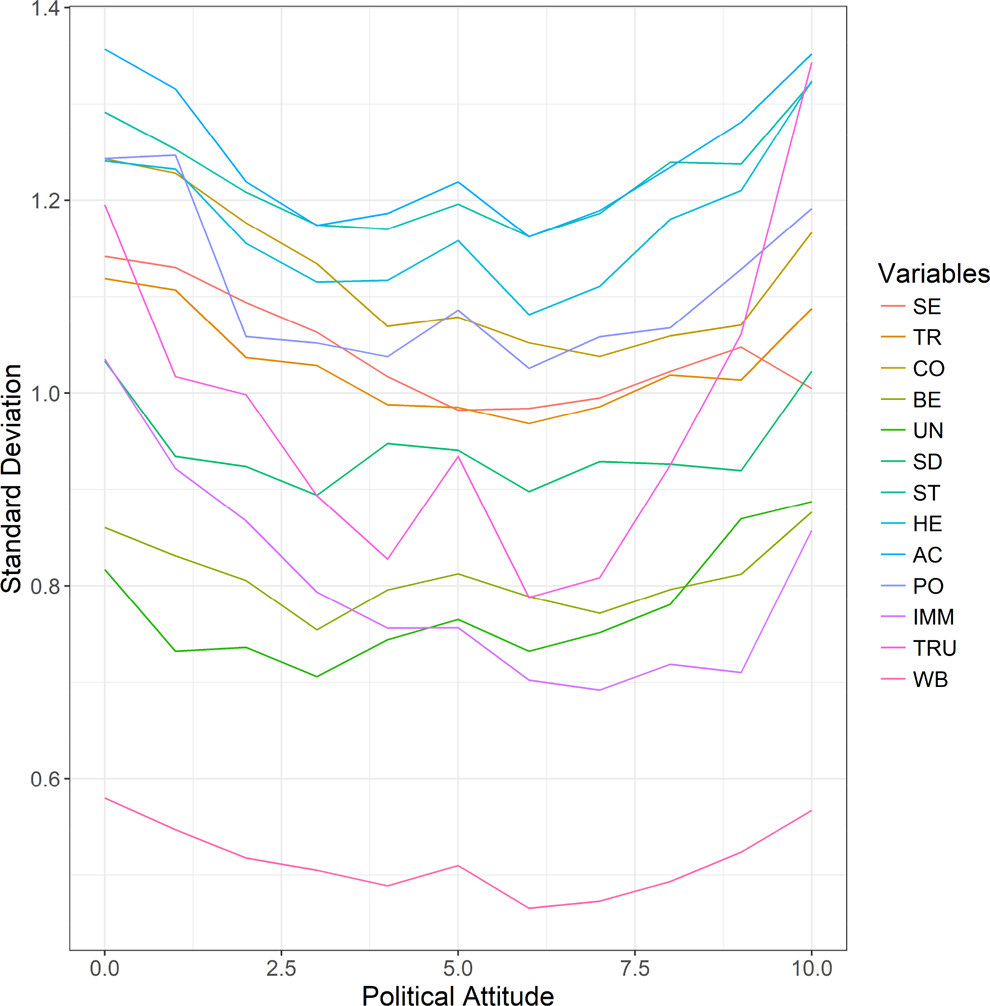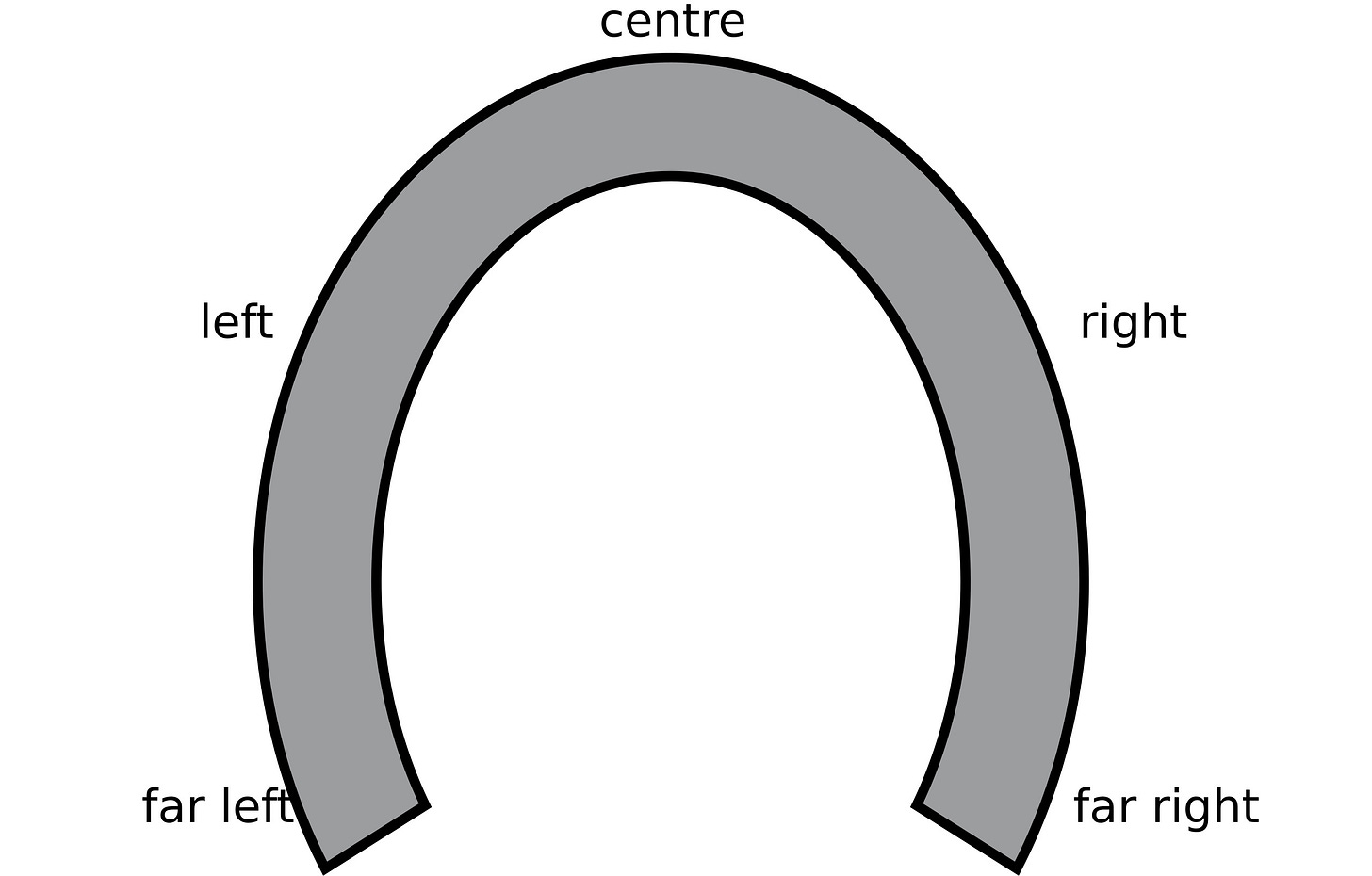Horseshoe Theory Is True, Horseshoe Theory Is False
Extremists are all alike: what they have in common is extremism
1. Horseshoe Theory Is…
My favorite teacher in high school taught me Global Politics, and at some point in an after-class conversation, she also taught me about horseshoe theory.
Her story is sort of a weird one: she’s Jewish, by birth, but was sorta-Muslim for a little while, and did lots of pro-Palestinian activism in college. At some point, her activist friends found out she was Jewish and some of them started stalking and harassing her; she realized, “wow, these people suck,” and became a liberal Zionist.
In the course of all this turmoil, she wondered how the left could be so antisemitic, when obviously, given the Holocaust and all, antisemitism was a rightist thing. And she settled on horseshoe theory as an explanation: the idea that extremists on the left and right ends of the political spectrum end up a lot more alike to each other than they are to centrists.
Here’s a picture, in case you’re more of a visual learner:
On October 7, 2023, Hamas killed a bunch of Israelis, and in the next months, I became pretty much convinced that my teacher was right. The far left could be just as loony as the far right. In some cases, *cough cough Queers For Palestine cough*, the far left explicitly endorsed far right groups and ideologies.
And evidence for horseshoe theory transcends even the Jews: people often think of Stalin—an extreme leftist—and Hitler—the rightiest of rightists—as two sides of the same authoritarian coin. In Ukraine, before Zelenskyy’s stabilizing win, the radical left and ultra-right were poised to form a victorious “Red-Brown coalition.” And in the UK, just a year ago, a far-right politician endorsed a far-left Workers Party candidate, encouraging voters to “stick two fingers up to the rotten political elite and their fake news media cronies.”
The most glaring example, which I’ve written about before, is the Bernie-to-Trump voter. The guy—yeah, mostly guys—who didn’t much care whether it was a light-socialist or light-fascist telling him that the elites sucked, just so long as they were telling him that the elites suck.
2. …Another Word For Populism
You’ll note that I actually haven’t given a very diverse cast of examples. And that’s because none exists: all the evidence for horseshoe theory consists in one side saying “fuck the elites” and then the other side saying “fuck the elites,” at which some centrist elite points and sputters.
It’s a true pattern, of course. Anti-elite sentiment exists on both the far left and the far right, and it’s good to recognize that this is the case and that we should maybe do something about it. But I don’t think it’s helpful to jump from this to “leftists and rightists are actually basically the same.”
Because they’re not! They’re simply not!
The real thought-leaders of right-wing ideology—your Carl Schmitts and Nick Lands and Moldbugs—hold markedly different views from committed leftists—people like Marx or Debs or deBoer.
The former hold actual positively right-wing views: they think democracy and egalitarianism are dumb, they think women and minorities suck, and so on. And the latter think differen things! They have a totally different worldview, one that’s fairly nonplussed about democracy, totally obsessed with egalitarianism, and all over the place on social justice, though mostly in agreement with it.
Leftism and Rightism, as political ideologies, are truly fundamentally distinct. They identify totally different sources of evil, and prescribe totally different solutions. They’re both utopian, but, hell, who isn’t utopian! Their utopias, certainly, look vastly different—on the left, everyone’s teaching theory on the commune; on the right, everyone’s doing lots of push-ups all the time, and if you can’t do enough push-ups, you get converted into biodiesel.
Both visions are insane—but they’re each insane in their own way!
3. Why Does The Horseshoe Still Happen?
If Leftism and Rightism are so vastly different, why do leftists and rightists seem so similar? Why do they say the same things and cross-endorse each other all the time? Something mysterious is happening here: if horseshoe theory is wrong, where does the populist horseshoe come from?
Well, I think it’s down to the fact that Leftism and Rightism are really terrible political ideologies. They suck, they would do bad things to society, and so they don’t win. Their thoughtful, committed adherents lose election after election, and the political elite is formed to their exclusion.
The extremists aren’t so happy about this, and they begin to reorient their politics around elite hatred. Marxists begin to talk less about Marxism, and more about vampiric billionaires; Rightists talk less about Rightism, and more about draining the swamp.
And all of a sudden, they start to get more popular! No one likes political philosophy; it’s very boring—but everyone loves dunking on the elites. Everyone wants some shadowy cabal to blame for their problems and failures, and the centrists, being the shadowy cabal, won’t give them anything! So they turn to the extremists, and the extremists, so glad to finally have a chance at success, double-down on the anti-elitism. It’s a means to an end, they think to themselves: once in power, they’ll be able to bring about their ideological utopia.
And so the two sides end up attracting mostly the same kinds of people: status-quo haters. The immiserated masses, the Gribblists, Low Human Capital.
When some sociologists ran a survey of 40,000 European voters, they found basically this result. Centrists tended to cluster around the same political values, whereas extremists on either end of the spectrum were much more heterogenous.

The study authors wrote, “our findings suggest that speaking of ‘extreme left-wing values’ or ‘extreme right-wing values’ may not be meaningful.”
They’re wrong, though.
Rightist and Leftist values are hard to find in the general population, sure—but among the most politically active people, they’re definitely still around! In another survey of around 70 political activists, social psychologist Alain Van Hiel found significant differences between the beliefs of left- and right-wing agitators:
So the horseshoe is a mirage! The far left and far right appeal to broadly similar voting blocs—disgruntled, cognitively-inflexible, conspiratorial morons—but their leaders, the ones actually getting elected, really are as dissimilar as can be.







Moreover, there isn't really a "leftism" or a "rightism". These aren't political ideologies, but vague directions of movement. They're umbrella terms. Communists, anarchists, socialists, social democrats, bleeding heart libertarians, establishment liberals etc. might all be described as being on the left but they hold substantively different views to one another. Likewise, one-nation Tories, ancaps, neocons, minarchists, paleocons, estoreric fascists, Strasserists etc. can all be described as being on the right, but they also all disagree.
A lot of what the center does isn't popular and would never win elections. Biden letting in millions of immigrants, the constant ratcheting up of the surveillance state by both typical conservatives and liberals, the Fed's commitment to a constant and 'normal' inflation rate. These are just things that have had clandestine elite support for a long time.
One could call One Billion Americans centrist extremism in this regard - it is obviously inane and will lead to bad outcomes, but one could see it plausibly occurring without any radical political changes.